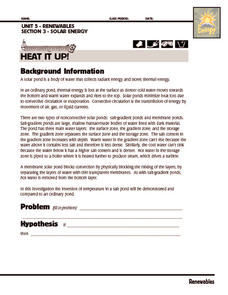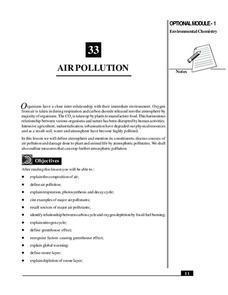Teach Engineering
Density Column Lab - Part 1
Mass and density — aren't they the same thing? This activity has groups use balance beams and water displacement to measure several objects. The pupils use the measurements to calculate the density of the objects.
Curated OER
Environmental Problems and Solutions
In this environmental problems and solutions worksheet, learners are given a list of 25 environmental problems. They match them with a given solution and paste the matching pairs to a piece of construction paper.
Curated OER
Environmental Issues
For this environmental issues worksheet, students are given 10 current topics that are problems in our environment today. They complete sentences about each topic by filling in the blanks with the appropriate terms. Some of the issues...
Curated OER
Integrating Environmental Science: Plastics
In this plastics instructional activity, students read about the uses of plastics and their environmental impact. Students answer questions about plastics and their use.
Curated OER
Regents High School Exam: Living Environment 2008
Tne New York Regents High School Examinations are comprehensive and include various styles of questions, includingmultiple choice and the analysis of graphs. This particular version, the 2008 Living Environment exam surveys a variety of...
Curated OER
Regents High School Examination: Living Environment 2005
The 2005 version of the Regents High School Examination in the area of ecology is as comprehensive as previous years' exams. It consists of 40 multiple choice questions on everything from the structure of DNA to the interactions within...
Curated OER
Regents High School Examination: Living Environment 2003
The living environment, from the interior of a cell to the complex relationships among populations, are queried in this final examination. Learners look at air pollution maps, diagrams of cells, population graphs, and drawing of cells....
Nevada Outdoor School
Let It Snow! Let It Melt!
Winter weather offers a great opportunity to teach young scientists about the states of matter. This activity-based lesson includes a range of learning experiences, from experimenting with the rate at which ice melts...
Curated OER
Human Impact on the Environment
In this environmental science worksheet, students complete a crossword puzzle with 26 questions about human impact on the environment.
Curated OER
What Happened to the Chesapeake Bay Filtering System?
In this environmental science lesson, learners write a short story about what it's like to help at an oyster garden. They formulate 2 hypotheses on the disappearance of oysters in Chesapeake Bay.
Curated OER
Control of the Cell Cycle
In this cell cycle worksheet, students will study genetic factors and environmental factors that affect the cell cycle. Students will use this idea map to complete 4 short answer questions.
Disney
Earth Day Guide to Being Green
Have fun completing Earth Day related activities while learning about simple ways to preserve the Earth. Implement some of the ideas for going green as a class, like cleaning up a local park or planting a tree at school.
Curated OER
Monitoring River Levels
In this environmental science worksheet, students read and study water maps from an interactive website to complete 8 short answer questions that follow.
University of Georgia
Heating and Cooling of Land Forms
Compare heating and cooling rates of different land forms. A lab activity has groups collect data on the rate of heating and cooling of soil, grass, saltwater, fresh water, and sand. An analysis of the rates shows how the different land...
Curated OER
Fitting In-Animals' Adaptations to Their Environment
In this animals' adaptation to their environment instructional activity, students read for comprehension and ability to apply knowledge. In this T-Chart and creative activities instructional activity, students answer three questions.
Curated OER
An Oil Spill Primer for Students
In this Gulf oil spill worksheet, students examine a 4-page article regarding basic facts about the oil spill as well as photographs of clean-up efforts.
Texas State Energy Conservation Office
Investigation: Heat it Up!
This demonstration of solar ponds can be used in an earth, environmental, or physical science setting. Lab groups set up a solar pond and model how it is able, due to a salt concentration gradient, to maintain heat for future use.
Maryland Department of Natural Resources
Eyes on Dissolved Oxygen
Learn about the factors that affect the way oxygen dissolves in salt water with a chemistry lab. After studying the molecular structure of water, young scientists figure out how aeration, temperature, and organic waste affect...
National Institute of Open Schooling
Air Pollution
Seventy percent of the air pollution in China is due to car exhaust. Under the umbrella of environmental chemistry, learners extensively explore air pollution. From the makeup of our atmosphere to sources of major air pollutants, classes...
Beyond Benign
The Big Melt: Arctic Ice Caps
Are the Arctic ice caps really melting out of existence? Junior climatologists examine the statistics of ice decline through four math-based lessons. Each activity incorporates data, climate information, and environmental impact into an...
Curated OER
Earth Day Quiz
In this environment learning exercise, learners demonstrate knowledge about Earth Day and current environmental issues by completing a 6 question multiple choice quiz.
Curated OER
Home Survey: What Kind of Energy?
In this environmental awareness instructional activity, students become aware of home energy conservation and recycling. Students answer 10 short essay questions about the energy used in daily life.
Curated OER
The Nitty Gritty-The Source and What To Do
In this environmental contaminants worksheet, students read about a scenario where children were exposed to lead from an old painted bench at a park. Students answer 5 questions about the investigation and what should be done to protect...
Curated OER
D is for Dump
In this pollution learning exercise, students read the sentences 'Don't dump pollution in the water,' and 'D .' Students may color the picture of the no dumping image.























